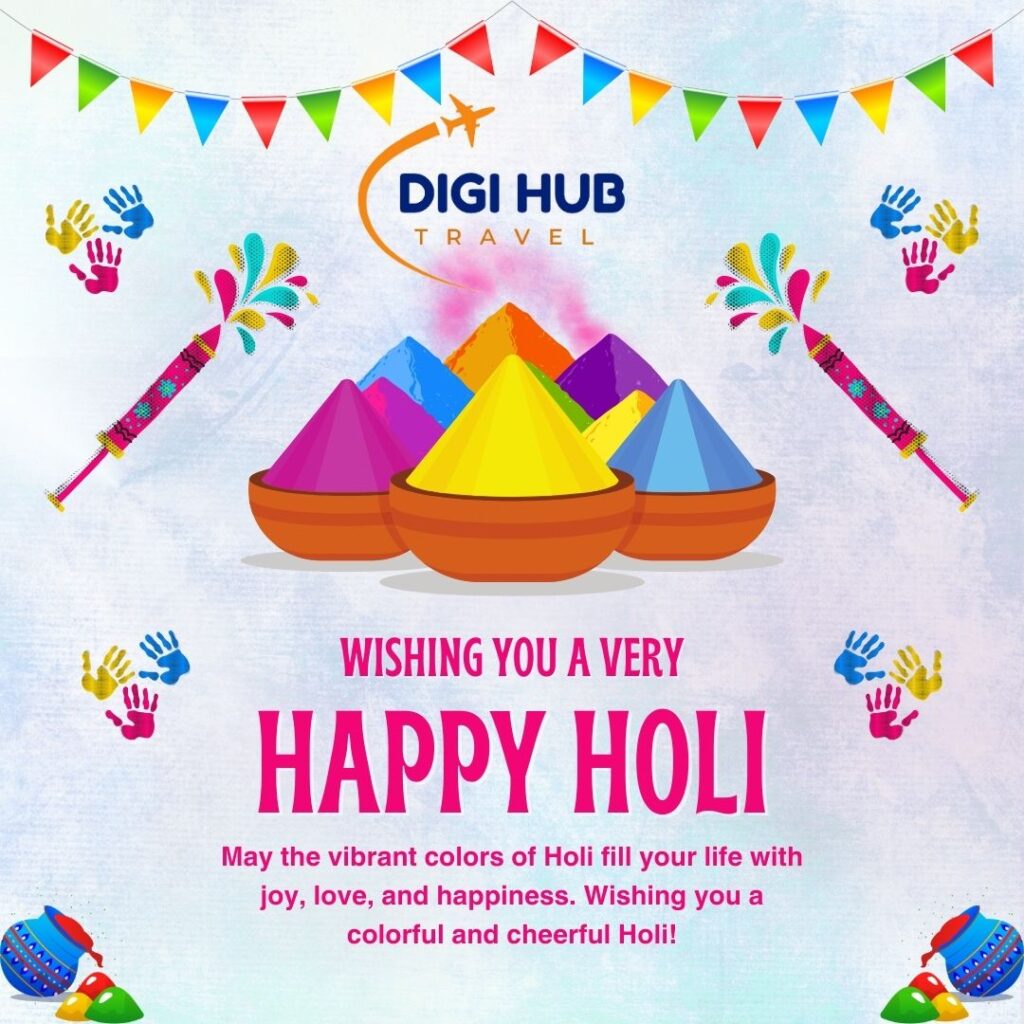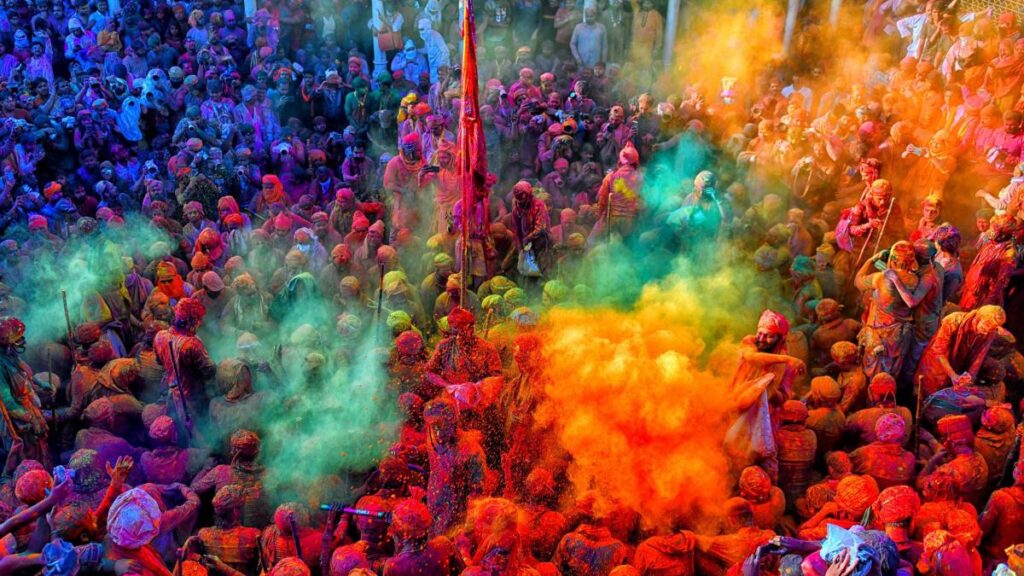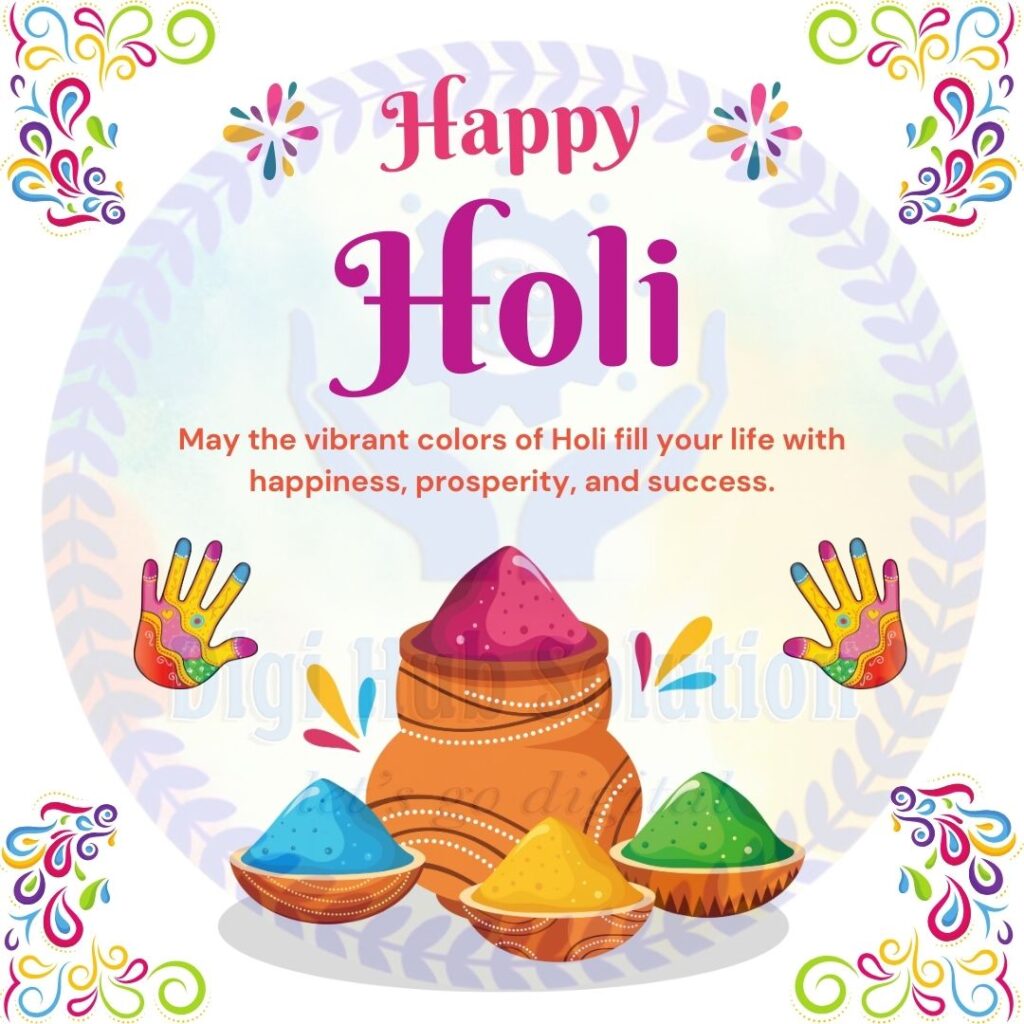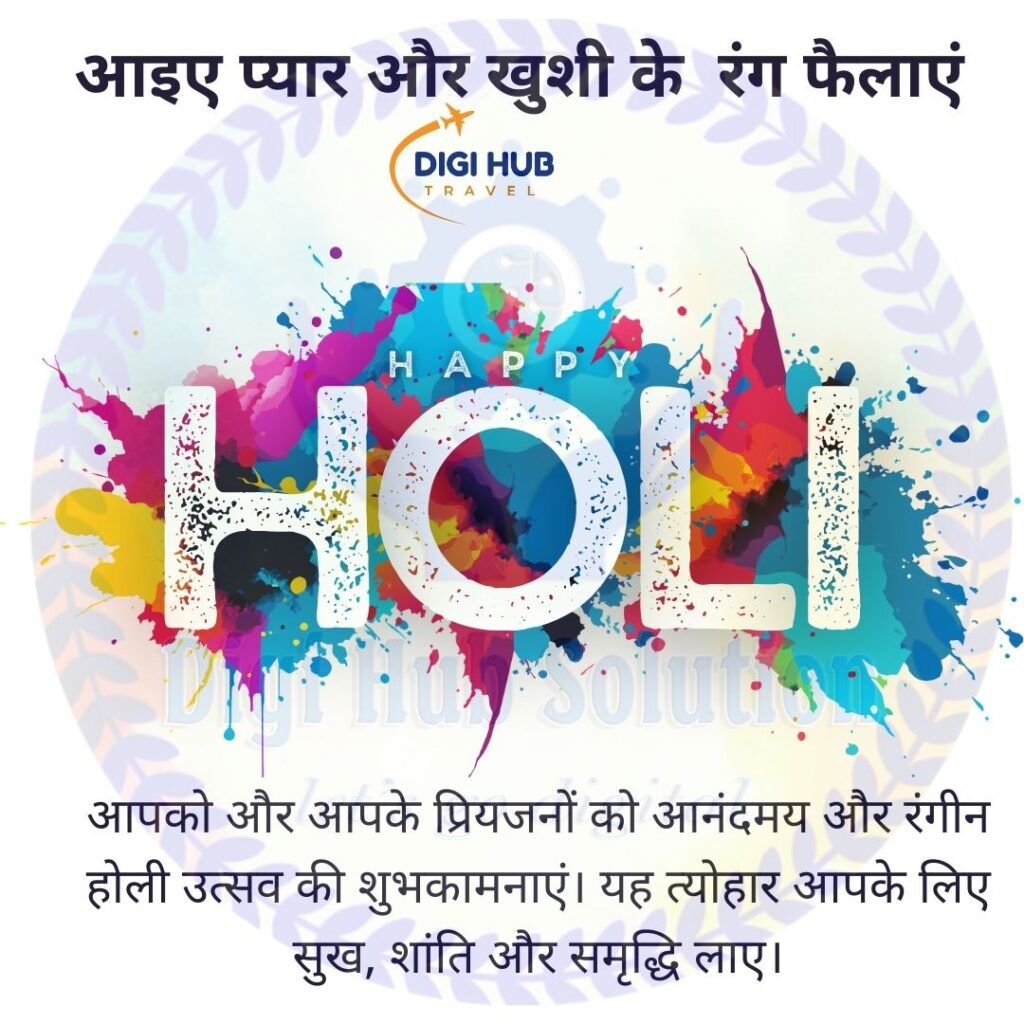Holi is an important Indian festival celebrated in the spring season. This festival is celebrated on the full moon day of Phalgun month according to the Hindu calendar. Holi is a festival of colors and happiness. This is one of the major and famous festivals of India, this festival called the festival of colors which is celebrated with great pomp all over the world today. Where minority Hindu people live. This festival, called the festival of colours, is traditionally celebrated for two days. It is mainly celebrated in India and Nepal. Holika Dahan, also known as Holika Dahan, is performed on the first day. On the second day, which is mainly known as Dhulendi and Dhurdi, Dhurkhel or Dhulivandan, people throw colors, Abir-Gulaal etc. on each other, Holi songs are sung by playing drums and people go door to door. Color is applied. Is. It is believed that on the day of Holi, people forget old bitterness and embrace each other, establish loving relationships and become friends again. The process of painting each other and singing continues till noon. After this, after taking bath and wearing new clothes, people go to each other’s house in the evening, hug and feed sweets.

This popular festival of Raga-Rang is also the messenger of spring season. Raga i.e. music and color are its main parts, the nature which takes them to heights is also at its peak at this time with colorful youth. Because it is celebrated in the month of Phalgun, it is also called Phalguni. The festival of Holi starts from Vasant Panchami itself. On this day, Gulal is blown for the first time. The singing of Phag and Dhamar starts from this day. Mustard crop blooms in the fields. There is an attractive display of flowers in the gardens. Trees, plants, animals, birds and humans are all filled with joy. The ears of wheat start fluttering in the fields. Be it children or old, everyone forgets all the hesitations and conventions and gets immersed in dance, music and colors accompanied by the beats of dholak, cymbals and manjiras. There is a splash of colors all around. Gujhiya is the main dish of Holi made from mawa (khoya) and flour and filled with dry fruits. There is also a tradition of eating and feeding Kanji in large quantities on this day.
History
Holi is an ancient festival of India which was celebrated by the name Holi, Holika. Because it is celebrated with great enthusiasm in the spring season, it is also called Vasanthotsav and Kama-Mahotsav. Historians believe that this festival was also prevalent among the Aryans but it was mostly celebrated in Eastern India only. Description of this festival is found in many ancient religious texts. Prominent among these are Jaimini’s Purva Mimamsa-Sutra and Katha Garhya-Sutra. This festival is also mentioned in ancient manuscripts and texts of Puranas like Narada Purana and Bhavishya Purana. It has also been mentioned in an inscription of 300 years before Christ located at Ramgarh place in Vindhya region. In Sanskrit literature, spring season and spring festival have been favorite subjects of many poets.

The famous Muslim tourist Alberuni has also described Holikotsav in his historical travel memoirs. Many Muslim poets of India have mentioned in their works that Holikotsav is celebrated not only by Hindus but also by Muslims. The most authentic historical photographs are from the Mughal period and the stories of Holi from this period are interesting. It describes Akbar playing Holi with Jodha Bai and Jahangir playing Holi with Noor Jahan. A painting in the Alwar Museum shows Jahangir playing Holi. By the time of Shahjahan, the Mughal style of playing Holi had changed. It is mentioned in history that during the time of Shahjahan, Holi was called Eid-e-Gulaabi or Aab-e-Pashi (shower of colours). It is famous about the last Mughal emperor Bahadur Shah Zafar that his ministers used to visit him to apply colors on Holi. Detailed description of Holi is also found in the Leelas of Krishna depicted in medieval Hindi literature.
Stories
In ancient times there was a very powerful demon named Hiranyakashipu. Due to arrogance of his power, he started considering himself as God. He had banned taking the name of God in his kingdom. Hiranyakashipu’s son Prahlad was a devotee of God. Angered by Prahlad’s devotion to God, Hiranyakashipu gave him many harsh punishments, but he did not leave the path of devotion to God. Hiranyakashipu’s sister Holika had so much power that she could not be destroyed in fire. Hiranyakashipu ordered that Holika sit in the fire with Prahlad in her lap. Holika got burnt while sitting in the fire, but Prahlad was saved. On this day Holi is lit in the memory of Lord devotee Prahlad. Symbolically it is also believed that Prahlad means happiness. Holika (firewood), symbolizing enmity and oppression, gets burnt and Prahlad (Anand), symbolizing love and joy, remains intact.

According to another story, Lord Vishnu worshiped Dhuli at the beginning of Tretayuga. Therefore this festival of Holi is also celebrated by the name of Dhulendi. Dhulendi is celebrated the next day of Holi in which people apply dust and mud on each other and it is called dust bath.
Traditions
Like the festival of Holi, its traditions are also very ancient and its form and purpose has been changing with time. In ancient times it was celebrated by married women for the happiness and prosperity of the family and there was a tradition of worshiping the full moon. In the Vedic period, this festival was called Navatrashti Yagya. At that time, the practice of accepting prasad by donating half-cooked farm food in the Yagya was prevalent in the society. The food is called Hola, hence the name Holikotsav. According to Indian astrology, the new year is also considered to begin from the day of Chaitra Shudi Pratipada. The month of Chaitra begins only after this festival. Therefore, this festival also marks the beginning of the new year and the arrival of spring. The first man Manu was born on this day, hence it is called Manvadithithi.
The first task of Holi is to plant the flag or stick. It is buried in a public place or in the courtyard of the house. Holika fire is collected near this place. All these preparations start much before Holi. The first day of the festival is called the day of Holika Dahan. On this day, Holi is lit at intersections and wherever sufficient wood is collected for fire. It mainly consists of wood and cow dung cakes. At many places there is also a tradition of burning Bharbholi during Holika. Bharbholi are dumplings made from cow dung with a hole in the middle. A rosary is made by inserting a moong rosary into this hole. There are seven Bharbholiyas in a garland. Before lighting the fire in Holi, this garland is passed seven times over the heads of the brothers and thrown away. During Holika Dahan at night, this garland is burnt along with Holika. This means that along with Holi, the evil eye on the brothers should also be burnt. The formal worship of this Holi made of wood and cow dung cakes starts from noon itself. Home cooked dishes are served here. Holi is lit at the end of the day at an auspicious time determined by astrologers. In this fire, wheat ears of new crop and chaff of gram are also roasted. Holika Dahan symbolizes the end of all the evils of the society. It indicates the victory of good over evil. In villages people sing and dance Holi songs till late night.

The next day of Holi is called Dhulivandan. On this day people play with colors. As soon as the morning comes, everyone sets out to meet their friends and relatives. Everyone is welcomed with gulal and colours. People forget the feelings of jealousy and hatred and embrace each other lovingly and apply colors to each other. On this day, groups are seen dancing and singing everywhere wearing colorful clothes. Children entertain themselves by releasing colors from the water spray. The entire society becomes united by getting colored in the colors of Holi. After playing with colors, people take bath in the afternoon and in the evening wear new clothes and go to meet everyone. Preeti organizes feasts and singing programs.
On the day of Holi, various types of dishes (food items) like kheer, puri and pura etc. are prepared in homes. Many sweets are made on this occasion, among which Gujis have a very important place. Besan Sev and Dahi Vada is also commonly prepared and served in every family living in Uttar Pradesh. Kanji, Bhang and Thandai are the special drinks of this festival.
Special celebration
In India, the festival of Holi is celebrated with variations in different regions. Holi of Braj is still a point of attraction for the entire country. The Lathmar Holi of Barsana is quite famous. In this, men put colors on women and women beat them with sticks and whips made of cloth. Similarly, in Mathura and Vrindavan also, the festival of Holi is celebrated for 15 days. Classical music seminars areheld in Geet Baithaki of Kumaon. It all starts several days before Holi. In Dhulandi of Haryana, there is a tradition of harassing the brother-inlaw by the sister-inlaw. Dol Jatra of Bengal is celebrated as the birthday of Chaitanya-Mahaprabhu. Processions take place and music is also played. Apart from this, there is a tradition of playing dry gulal in Rang Panchami of Maharashtra, organizing cultural programs after taking out procession in Shimgo of Goa and display of strength by Sikhs in Hola Mohalla of Punjab. Kaman Podigai of Tamil Nadu is a spring festival mainly based on the story of Kamadeva, while in Yaosang of Manipur, Yongsang is the name of a small hut which is built on the banks of a river or lake in every town and village on the day of full moon. Holi is the biggest festival for the tribals of South Gujarat, Hori of Chhattisgarh has a wonderful tradition of folk songs and in the tribal areas of Malwaregion of Madhya Pradesh, Bhagoriya, which is a form of Holi, is celebrated with great pomp. Fagua of Bihar is a festival of great fun and Holi of Nepal shows religious and cultural colors on it. Similarly, immigrants settled in different countries and religious institutions like ISKCON or Banke Bihari Temple of Vrindavan have traditions of decorating and celebrating Holi in different ways, in which there are many similarities and differences.

In modern times
Chemical colours, many people are themselves returning to natural colours. The growing international popularity of Holi is also beginning to take shape. Its usefulness in the market can be gauged from the new perfume Holi Hai released by KenzoAmur, an international establishment, on the occasion of Holi this year.
Environment. Such people and organization are maintaining the tradition of playing Holi with sandalwood, rose water, colors made from Tesu flowers and natural colours, and are also making important contribution to its development. After becoming aware of the ill effectsof chemical colours.

Holi is a festival of colors, a festival of laughter and happiness, but many forms of Holi can be seen. Some of its modern forms are – use of chemical colors in place of natural colours, drug addiction in place of cannabis and use of film songs in place of folk music. But this does not diminish the glory of Dhol, Manjire, Phag, Dhamar, Chaiti and Thumri sung and played on Holi. There are many people who understand traditional music and are environmentally conscious.
Literature
There is a detailed description of many forms of Holi in ancient Sanskrit literature. In Shrimad Bhagwat Mahapuran, there is a description of Rasa, a group of Rasas. Other works describing the festival called ‘Rang” include Harsha’s Priyadarshika and Ratnavali and Kalidasa’s Kumarasambhavam and Malavikagnimitram. In Ritusandar written by Kalidas, an entire canto is dedicated to ‘Vasantotsav’. Bharavi, Magh and many other Sanskrit poets have discussed spring a lot. Holi is described in the first Hindi epic, Prithviraj Raso, written by Chand Bardai. The months of Holi and Phalgun have had special significance in the Hindi literature of Bhakti period and Ritika period. From the ancient poet Vidyapati to the Bhakti period Surdas, Rahim, Raskhan, Padmakar, Jayasi, Mirabai, Kabir and the traditional poets Bihari, Keshav, Ghananand etc. this subject has been dear to many poets. Great poet Surdas has written 78 verses on spring and Holi. Padmakar has also written numerous compositions on the theme of Holi. Through this theme, while on one hand the poets have described the Holi of love and affection played between the very worldly hero and heroine, on the other hand, through the Holi full of love and molestation played between Radha Krishna, the devotional love incarnate in sagun and nirgun has been described. Have executed formless devotional love. Poets following Muslim sect like sufi saint Hazrat Nizamuddin Auliya, Amir Khusro and Bahadur Shah Zafar have also written beautiful compositions on Holi which are popular among the common people even today. Different forms of Holi can be seen in modern Hindi stories Raja Hardol by Premchand, Alag Alag Teeliyan by Prabhu Joshi, Ek Baar Phir Holi by Tejendra Sharma, Holi Mangalmay Ho by Om Prakash Awasthi and Ho Li by Swadesh Rana. Holi scenes and songs have also been beautifully depicted in Indian films.
Music
Holi has special significance in the traditions of Indian classical, sub-classical, folk and film music. In classical music, Dhamar has a deep connection with Holi, however, the beauty of Holi songs in Dhrupad, Dhamar, Chhote and Bade Khayal and Thumri is also visible. Many beautiful Bandishes presented on Holi, Dhamar and Thumri along with Kathak dance like Chalo Guniyan Aaj Khele Hori Kanhaiya Ghar are extremely popular even today. A popular bandish sung in Dhrupad is Khelat Hari Sang Sakal, Rang Bhari Hori Sakhi. There are some ragas in Indian classical music in which Holi songs are especially sung. There are many such ragas like Basant, Bahar, Hindol and many more. Playing songs on Holi automatically creates an atmosphere and its color starts affecting people. In classical music, there are many famous Holis in Chaiti, Dadra and Thumri. The popularity of music on the occasion of Holi can be gauged from the fact that the name of a special style of music is Holi, in which different descriptions of Holi are heard in different provinces, in which the history and religious significance of that place is hidden. It happens. While in Brajdham there are descriptions of Radha and Krishna playing Holi, in Awadh, Raghuveera plays Holi like Ram and Sita. Holi sung at the Dargah of Khwaja Moinuddin Chishti in Ajmer city of Rajasthan has a special colour. One of his famous Holi is Aaj Rang Hai Ri Man Rang Hai, Apne Mehboob Ke Ghar Rang Hai Ri. Similarly, in a Holi related to Shankar ji, there is a description of Shiva playing Holi in the cremation ground by saying Digambar Khela Masane Mein Holi. Holi songs based on different ragas have also been presented in Indian films, which have become quite popular. Even today people have not been able to forget the songs Rang Barse Bheege Chunar Wali, Rang Barse from ‘Silsila’ and Aaya Holi Ka Utsav, Ude Rangdon Ki Bauchaar from ‘Navrang’.
Use of colors
In ancient times, people used to play Holi with sandalwood and gulal only. Changes have also been seen in these with time. Natural colors are also being used by many people, so that there is no adverse effect on the skin or eyes.


